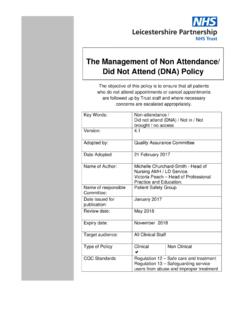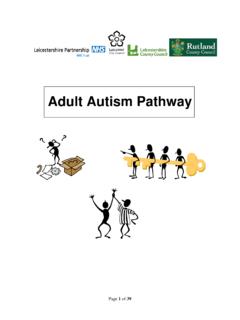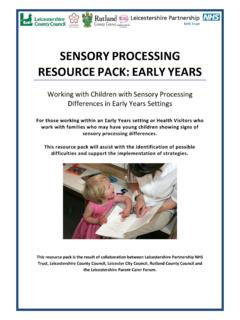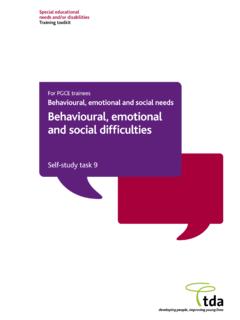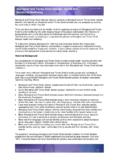Transcription of Strengths and Difficulties Questionnaire (SDQ)
1 1 Strengths and Difficulties Questionnaire (SDQ) What is the SDQ: The Strengths and Difficulties Questionnaire (SDQ) is a short behavioural screening Questionnaire used for 3-16 year olds and is available in over 40 different languages. It is used within research, evaluating treatment outcome and as part of clinical assessment in order to examine a child s mental well-being. This standardised Questionnaire has good psychometric properties (McPherson et al., 2006) and has been used with community (Goodman, Ford, Simmons, Gatward & Meltzer, 2000), Looked After Children (LAC) (Mason, Chmelka & Thompson, 2012) and other clinical and non-clinical child and adolescent populations (Goodman, Renfrew& Mullick, 2000). It helps social and mental health workers to make decisions quickly and acts as a guide when planning treatment. In a review by the Department of Health, feedback from social workers included that the Questionnaire gave a more in-depth look at the young person , and that it could be a springboard for therapeutic action (Department of Health, pp.)
2 2b). Note: As the SDQ is self-report in nature, the validity of the tool is not always ensured, and should therefore be considered as part of a wider assessment process and not as a standalone tool. Accessibility: All versions of the SDQ are available free of charge on the Youth in Mind website (See link below) (UK) NOTE: As per Best Practice Guidelines, Foster carers, Teachers and the Young Person themselves should be administered the SDQ in order to improve the validity of results. It is particularly important to collect information from Teachers if the validity of the Foster Carer report is uncertain. 2 How to use: When used within social work, the Double Sided Version of the SDQ is completed. This includes a Psychological Attributes Component and an Impact Supplement. Psychological Attributes Component The SDQ examines 25 attributes, divided between 5 scales: 1. Emotional problems 2. Conduct problems 3. Hyperactivity and inattention 4. Peer relationship problems 5.
3 Prosocial behaviours (Excluded from Total Difficulties score) The administration of the Psychological Attributes Component varies according to the age or demographics of children or Young People being tested. The self-report version of the SDQ is suitable for young people aged between 11-16 however this varies depending on the young person s level of understanding and literacy. Impact supplement The impact supplement examines the nature of a young person s problems, completed by parents and teachers. Information collected includes burden to others, social impairment, chronicity and distress related to a reported problem. Scoring: Once completed, the SDQ can be scored using the Fast SDQ Scoring Site on the Youth in Mind website (See link blow). Input the results from the Questionnaire into the online system and a set of final scores will be generated, along with a categorisation for that score (close to average, slightly raised, high or very high). Further information about scoring the SDQ manually is available on the Youth in Mind website (See link blow).
4 3 Interpretation of results: A total Difficulties score is calculated using the SDQ, which ranges from 0-40. Each 1 point increase in the total Difficulties score corresponds with an increase in the risk of developing a mental health disorder. Categories have been proposed by Youth in Mind authors in order to assess whether a child s score is close to average, slightly above average, high or very high. The cut-off scores for the SDQ are outlined in Table 1. Table 1: Categorising SDQ Scores for 4-17 year olds (Not validated for 18+) Close to average Slightly Raised High Very High Parent completed SDQ Total Difficulties score 0-13 14-16 17-19 20-40 Emotional problems score 0-3 4 5-6 7-10 Conduct problems score 0-2 3 4-5 6-10 Hyperactivity score 0-5 6-7 8 9-10 Peer problems score 0-2 3 4 5-10 Prosocial score 8-10 7 6 0-5 Impact score 0 1 2 3-10 Teacher completed SDQ Total Difficulties score 0-11 12-15 16-18 19-40 Emotional problems score 0-3 4 5 6-10 Conduct problems score 0-2 3 4 5-10 Hyperactivity score 0-5 6-7 8 9-10 Peer problems score 0-2 3-4 5 6-10 Prosocial score 8-10 5 4 0-3 Impact score 0 1 2 3-6 Self- completed SDQ Total Difficulties score 0-14 15-17 18-19 20-40 Emotional problems score 0-4 5 6 7-10 Conduct problems score 0-3 4 5 6-10 Hyperactivity score 0-5 6 7 8-10 Peer problems score 0-2 3 4 5-10 Prosocial score 7-10 6 5 0-4 Impact score 0 1 2 3-10 Note that these scores only provide a rough and ready way of screening for disorders.
5 Com-bining information from SDQ symptom and impact scores from multiple informants is better, but still far from perfect. 4 What to do next: SDQ scores are useful when making decisions about what to do next with a young person or child within the care system. Total Difficulties Score The following chart provides an outline about what to do next depending on a child or Young Person s Total Difficulties score. Decision Matrix - What to do next Figure 1. Decision Matrix (Total Difficulties Score) - What to do next 5 Sub scores It is also important to consider a child or Young Person s sub-scores on the SDQ in order to examine if there is a particular area of difficulty for them. Social workers may then focus on ways to help the young person with these Difficulties . If the Hyperactivity score is elevated and there are concerns regarding ADHD then a referral to CAMHS should be considered. For children less than 9 years of age also consider a referral to the Community Paediatric team.
6 If the Peer Problems score is elevated then a consultation with school, involvement of a Youth Worker, involvement of a local Youth Group or work to improve social skills should be considered. If there are concerns regarding ASD in conjunction with an elevated Peer Problems score then a referral to CAMHS should be considered. For children less than 9 years of age also consider a referral to the Community Paedi-atric team. 6 References Department of Health (NA). Strengths and Difficulties : Guidance on Using Questionnaires. Retrieved on the 25th August 2016, from Goodman, R., Ford, T., Simmons, H., Gatward, R., & Meltzer, H. (2000). Using the Strengths and Difficulties Questionnaire (SDQ) to screen for child psychiatric disor-ders in a community sample. The British Journal of Psychiatry, 177(6), 534-539. Goodman, R., Renfrew, D., & Mullick, M. (2000). Predicting type of psychiatric disorder from Strengths and Difficulties Questionnaire (SDQ) scores in child mental health clinics in London and Dhaka.
7 European child & adolescent psychiatry, 9(2), 129-134. Kelly, C., Allan, S., Roscoe, P., & Herrick, E. (2003). The mental health needs of looked af-ter children: an integrated multi-agency model of care. Clinical Child Psychology and Psychiatry, 8(3), 323-335. Mason, W. A., Chmelka, M. B., & Thompson, R. W. (2012, October). Responsiveness of the Strengths and Difficulties Questionnaire (SDQ) in a sample of high-risk youth in resi-dential treatment. In Child & Youth Care Forum (Vol. 41, No. 5, pp. 479-492). Springer US. McPherson, K., Kersten, P., George, S., Lattimer, V., Breton, A., Ellis, B., .. & Frampton, G. (2006). A systematic review of evidence about extended roles for allied health profes-sionals. Journal of health services research & policy, 11(4), 240-247. YouthinMind (2012). What is the SDQ? Retrieved on the 20th May 2016, from 7 Table 2: Decision Matrix (Total Difficulties Score) - What to do next Total Difficulties Score Score Category Options for support Parent: 0-13 Teacher: 0-11 Self-report: 0-14 Close to Average Watchful waiting Monitoring Care as usual Parent: 14-16 Teacher: 12-15 Self-report: 15-17 Slightly Raised Professionals involved in care monitoring and providing additional support Social worker support to carers CIEPS service (City only) School Nurse Educational Psychology School counsellor LAC nurses Seek advice from Therapeutic services Parent: 17-19 Teacher: 16-18 Self-report: 18-19 High Therapeutic services The Child and Family Support Team (CFST) Consultation with CAMHS Through PAS Line (295 5048) Consultation with CAMHS Through YPT consultation clinics (done by Primary Mental Health Workers) or referral for consultations into the team.
8 Parent: 20-40 Teacher: 19-40 Self-report: 20-40 Very High Consider a referral to CAMHS 8 Figure 2. Decision Pyramid (Total Difficulties Score) - What to do next

